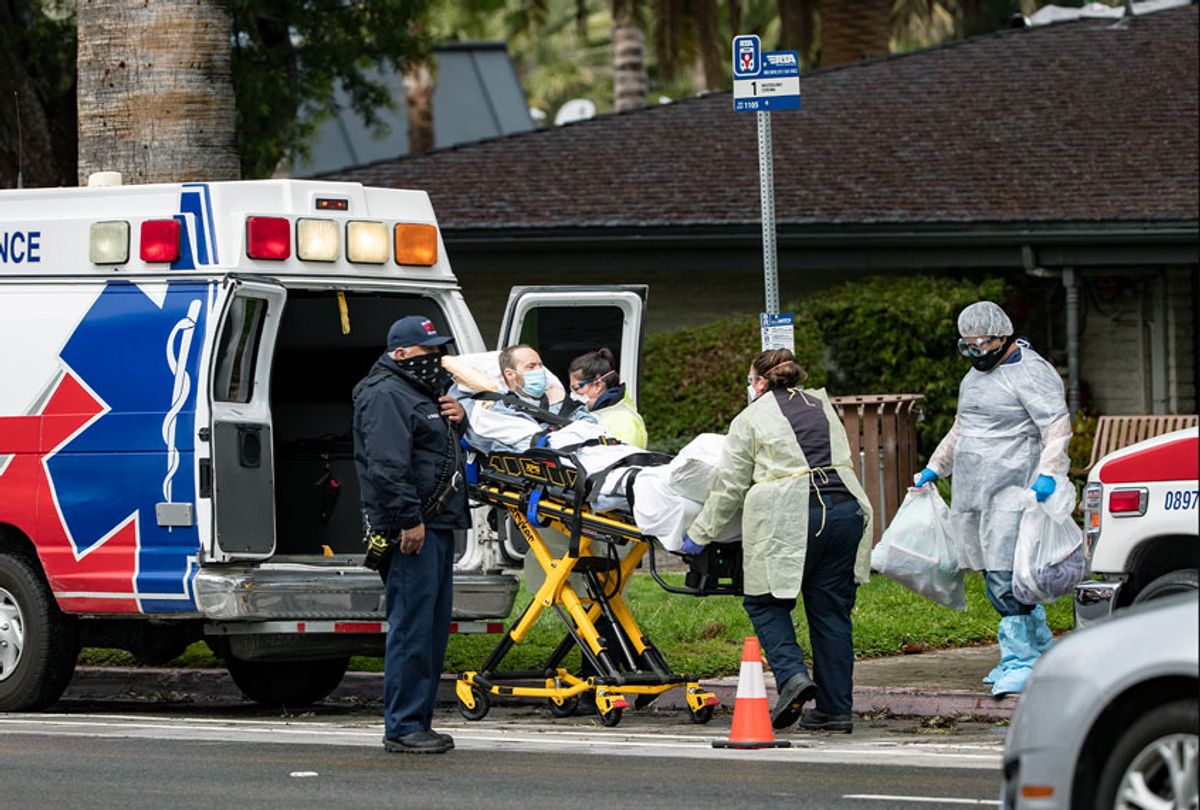For many, the health disaster that has befallen Los Angeles County's skilled nursing facilities during the COVID-19 pandemic has been a dangerous recipe comprising slow response, lax oversight and profits superseding quality care. When it comes to blame, start with the Los Angeles County Department of Public Health (LAC DPH), the agency charged with policing these facilities.
By May the situation had become so dire so quickly that the L.A. County Board of Supervisors voted unanimously to appoint an inspector general (IG) to oversee the county's more than 300 such facilities and make recommendations for improvement. Today many are hoping the IG's upcoming interim report, whose release appears imminent, will help answer this burning question: How can the county turn things around and ensure that nursing home operators properly protect their residents?
Through the LAC DPH, Los Angeles is the only county in the state contracted by the California Department of Public Health (CDPH) to handle oversight of its own nursing homes. But last month, L.A. County skilled nursing facilities ombudsman Molly Davies, a frequent LAC DPH critic, asserted that the state should sever that contract – set to expire at the end of June 2025 – and pick up the reins of oversight itself. This isn't the first time such a call has been made. During contract negotiations last year, California Advocates for Nursing Home Reform (CANHR), another prominent critic of the nursing home industry, argued in a letter to the state senate against extending the contract due to L.A. County's "abysmal" performance.
"I would think it should be seriously considered," said Eric Carlson, directing attorney with Justice in Aging, an advocacy organization, about the idea of the state assuming oversight of L.A. County's nursing homes.
* * *
Nevertheless, many experts urge caution when it comes to state intervention – not least of all because of the CDPH's own troubled legacy of protecting California's nursing home residents. "Why do we assume the state will do it better?" warned Dr. Michael Wasserman, president of the California Association of Long Term Care Medicine.
A 2018 audit found that the state has not "adequately addressed ongoing deficiencies related to the quality of care that nursing facilities provide." California also has one of the highest rates of complaints per 1,000 nursing home residents in the country.
During the pandemic, the CDPH has come under fire for things like failing to provide vital testing for state nursing home inspectors, and for substantiating less than 3 percent of complaints made during the first four months of the pandemic, a marked drop from the same period two years before – leading experts to fear lax oversight.
Between the state and the county, "It's like rolling the dice – I don't think the state's much better," said Jamie Court, director of Consumer Watchdog, a nonprofit consumer advocacy organization.
And so, a second question emerges: What changes can and should LAC DPH – and, more specifically, the agency's Health Facilities Inspection Division (HFID), which directly oversees skilled nursing homes for the department – independently institute?
CANHR's Michael Connors breaks down his recommendations into a number of key areas, one of which concerns what he calls "epidemic levels" of abuse and neglect in L.A. County nursing homes. "Public officials never acknowledge it, or do anything to stop it," he said. Proper enforcement of minimum staffing requirements would help, Connors added. Indeed, this national study found 75 percent of the nation's nursing homes failed to meet federal nursing staff requirements.
Another problem, warn experts, is that many instances of elder abuse either go unreported or aren't properly investigated.
While state data shows that the number of open complaint cases in L.A. County has dropped in recent years, the average age of those cases has steadily grown and currently stands at more than three years – this, despite a state law requiring that investigations into nursing home complaints be completed within 120 days. "It's not uncommon for residents to die before complaints about their treatment are investigated," said Connors, who advocates for swift resolution of complaints but not by "sweeping them under the rug." There's damning precedent here. In an audit issued just six years ago, the state excoriated the county for a pattern of mishandling complaints.
Both advocates and industry insiders point to the need for tougher policing through more frequent and harsher penalties for at-fault nursing homes, a responsibility of both the county and the state. According to state data, the number of cited deficiencies that L.A. County has issued during the last quarter has almost halved from what it was at the end of 2019. The percentage of substantiated allegations is at its lowest level in nearly four years.
When it comes to monetary penalties, L.A. County nursing homes have been issued nearly $3.6 million in fines since the start of 2019, according to state data, but the bulk of the citations are for lesser Class B penalties, which come with a maximum fine of $2,000. Statewide during the fiscal year 2018-2019, only about 3% of the 18,520 deficiencies issued to California nursing homes resulted in a monetary citation.
"At for-profit entities, these skilled nursing facilities respond to fines," said Dr. Ying-Ying Goh, director of the Pasadena Public Health Department. Citations and requirements for an action plan "usually result in rapid compliance," she added.
An LAC DPH spokesperson responded to questions about the IG inspection and other issues for this story by saying that the agency is "working diligently to provide the Inspector General with all requested information for their investigation."
Capital & Main sent a similar list of questions to the nonprofit California Association of Health Facilities, which represents some 900 skilled nursing facilities and is the state's largest continuing education provider for long-term caregivers. In a statement, spokesperson Deborah Pacyna wrote that it's "not appropriate for us to comment on a contractual arrangement between the CDPH and LA County, particularly because of their regulatory oversight over our facilities."
Having said that, Pacyna added: "In general, our association doesn't think it makes sense for individual counties to set their own standards given what we've seen during the COVID pandemic. We've been experiencing a myriad of government regulations from a variety of county, state and federal entities. These interagency conflicts create a lot of confusion and needless administrative work for facilities as they try to figure out how to comply with different governmental directives."
Some experts see recent tough scrutiny of the nursing home industry in Los Angeles as an opportunity to discuss prescriptive, fundamental revisions to the status quo. The for-profit model underpinning much of the nursing home industry "works against achieving high-quality health care," said Goh, who raised the prospect of alternate models, like a nonprofit or a publicly funded system.
Numerous studies appear to show that nonprofit nursing homes provide better quality of care than their for-profit counterparts. One study, for example, found that for-profit nursing home residents were nearly twice as likely as those in nonprofit facilities to suffer health problems associated with poor care. Some, however, urge caution.
"Not-for profits have trouble also, and there are good not-for-profits and there are bad not-for-profits," said Wasserman, former CEO of the state's largest chain of for-profit nursing homes. Rather, he added, "We must minimize perverse incentives in the for-profit side of the industry." Towards that end, Wasserman and others look for broad shifts within county health department leadership. If at the top there isn't an understanding of the long-term care industry that's coupled with "transparency and accountability," he added, "then we're never going to get ahead of this."
Wasserman's views on the state of the agency's hierarchy is echoed by others. A new Capital & Main investigation found a pattern of systemic problems within the HFID, including "incompetant" management at the top. Tracy Greene Mintz, a licensed clinical social worker who provides consultation to nursing home social service departments, said that "entrenched leadership" at the county health department has led to an organization mired in "bureaucratic sludge."
* * *
The pandemic has hit Pasadena's nursing home residents especially hard. Over the past few months, state public health officials have taken control of two Pasadena nursing homes because of financial negligence, and suspended the license of another, Golden Cross Health Care, for quality of care problems. Pasadena Assistant City Manager Nicholas Rodriguez said that there are "serious management issues with the way in which nursing homes are monitored and addressed" in the county. During the pandemic, he said, there has been a revolving door of both state and county inspectors covering individual facilities, resulting in "disjointed communication" and mismanagement of "crisis situations."
Kenneth Hayashida, a retired physician and member of a community advisory board (CAB) that oversees four elder care facilities in L.A. County, also believes there's a "critical" absence of coordination in the way information is shared between the county, the public and nursing home operators that needs to be addressed. Hayashida shared with Capital & Main various emails he sent over many months to county health officials and to facility operators asking for important COVID-related health data, but which went unanswered – a scenario he described as ultimately "dangerous" for facility residents.
A not insignificant hurdle towards reform appears to be the tremendous sway that the nursing home industry exerts at both the political and administrative levels. While nursing homes have a powerful voice "through their professional trade organizations," said Rodriguez, "the patients have very little." Health care institutions are among the biggest spending lobbyists in the country. When the pandemic first struck, the CEO of California's largest nursing home industry group gained what The Sacramento Bee called "open-door access" to state regulators.
The "probability of influence" is "most concerning," said Wasserman. He pointed to an April "strategy" meeting between Los Angeles' county health department and operators of skilled nursing facilities, during which the county offered advice to the industry on such things as "positive messaging" surrounding COVID-positive facilities.
"What the county should care about is assuring the highest quality of care – they shouldn't be worried about what stakeholders think," said Wasserman, who advocates a restructuring of the HFID and the wider health department so that leadership positions are filled with individuals who make "evidence-based, expert-driven" decisions focused squarely on what's best for nursing home residents. "If [the inspector general's] report doesn't recommend significant change in the structure and function of the leadership of the department," he added, "I will be very disappointed."
Copyright 2020 Capital & Main


Shares